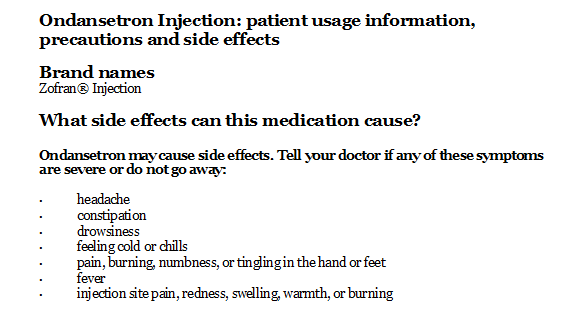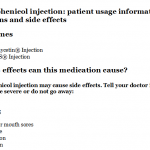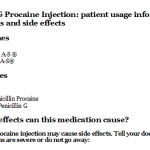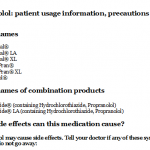
Ondansetron Injection: patient usage information, precautions and side effects
Tuesday, May 30, 2017 by Gregory Van Dyke
http://www.naturalnewsreference.com/2017-05-30-ondansetron-injection-patient-usage-information-precautions-and-side-effects.html

Ondansetron Injection: patient usage information, precautions and side effects
Brand names
Zofran® Injection
What side effects can this medication cause?
Ondansetron may cause side effects. Tell your doctor if any of these symptoms are severe or do not go away:
-
headache
-
constipation
-
drowsiness
-
feeling cold or chills
-
pain, burning, numbness, or tingling in the hand or feet
-
fever
-
injection site pain, redness, swelling, warmth, or burning
Some side effects can be serious. If you experience any of the following symptoms, call your doctor immediately or seek emergency medical treatment:
-
rash
-
hives
-
itching
-
swelling of the eyes, face, lips, tongue, throat, hands, feet, ankles, or lower legs
-
hoarseness
-
difficulty breathing or swallowing
-
chest pain
-
shortness of breath
-
dizziness, light-headedness, or fainting
-
fast, slow or irregular heartbeat
-
blurred vision or vision loss
-
lightheadedness
-
agitation
-
hallucinations (seeing things or hearing voices that do not exist)
-
fever
-
excessive sweating
-
confusion
-
nausea, vomiting, or diarrhea
-
loss of coordination
-
stiff or twitching muscles
-
seizures
-
coma (loss of consciousness)
Ondansetron may cause other side effects. Call your doctor if you have any unusual problems while you are using this medication.
If you experience a serious side effect, you or your doctor may send a report to the Food and Drug Administration’s (FDA) MedWatch Adverse Event Reporting program online (http://www.fda.gov/Safety/MedWatch) or by phone (1-800-332-1088).
Why is this medication prescribed?
Ondansetron injection is used to prevent nausea and vomiting caused by cancer chemotherapy and surgery. Ondansetron is in a class of medications called serotonin 5-HT3 receptor antagonists. It works by blocking the action of serotonin, a natural substance that may cause nausea and vomiting.
How should this medicine be used?
Ondansetron comes as a solution (liquid) to be injected intravenously (into a vein) or intramuscularly (into a muscle) by a health care provider in a hospital or clinic. When ondansetron is used to prevent nausea and vomiting caused by chemotherapy, it is usually given 30 minutes before the start of chemotherapy. Additional doses may be given 4 hours after the first dose of ondansetron and 8 hours after the first dose of ondansetron, if needed. When ondansetron is used to prevent nausea and vomiting caused by surgery, it is usually given just before the surgery. Ondansetron is also sometimes given after surgery to patients who are experiencing nausea and vomiting and who did not receive ondansetron before surgery.
This medication may be prescribed for other uses. Ask your doctor or pharmacist for more information.
What special precautions should I follow?
Before using ondansetron,
-
tell your doctor and pharmacist if you are allergic to ondansetron, alosetron (Lotronex), dolasetron (Anzemet), granisetron (Kytril), palonosetron (Aloxi), or any other medications: or any of the ingredients in ondansetron injection. Ask your pharmacist for a list of the ingredients.
-
tell your doctor if you are receiving apomorphine (Apokyn). Your doctor will probably tell you not to use ondansetron if you are receiving this medication.
-
tell your doctor and pharmacist what prescription and nonprescription medications, vitamins, nutritional supplements, and herbal products you are taking or plan to take. Be sure to mention any of the following: amiodarone (Cordarone, Pacerone); azithromycin (Zithromax); certain medications for seizures such as carbamazepine (Carbatrol, Epitol, Equetro, Tegretol), or phenytoin (Dilantin); chloroquine (Aralen); chlorpromazine ; citalopram (Celexa); clarithromycin (Biaxin, in Prevpac); diuretics (‘water pills’); erythromycin (E.E.S., Erythrocin, others); fentanyl (Abstral, Actiq, Duragesic, Fentora, Lazanda, Onsolis, Subsys); flecainide; haloperidol (Haldol); lithium (Lithobid); medications to treat migraines such as almotriptan (Axert), eletriptan (Relpax), frovatriptan (Frova), naratriptan (Amerge), rizatriptan (Maxalt), sumatriptan (Imitrex), and zolmitriptan (Zomig); methylene blue; mirtazapine (Remeron); monoamine oxidase (MAO) inhibitors including isocarboxazid (Marplan), linezolid (Zyvox), phenelzine (Nardil), selegiline (Eldepryl, Emsam, Zelapar), and tranylcypromine (Parnate); moxifloxacin (Avelox); pentamidine (Nebu-Pent); pimozide (Orap); procainamide; quinidine; rifampin (Rifadin, Rimactane, in Rifamate, in Rifater); selective serotonin/norepinephrine reuptake inhibitors (SNRIs) such as desvenlafaxine (Khedezla, Pristiq), duloxetine (Cymbalta), and venlafaxine (Effexor XR); selective serotonin reuptake inhibitors (SSRIs) such as citalopram (Celexa), escitalopram (Lexapro), fluoxetine (Prozac, Sarafem, in Symbyax), fluvoxamine (Luvox), paroxetine (Brisdelle, Paxil, Pexeva), and sertraline (Zoloft); sotalol (Betapace, Sorine); thioridazine; tramadol (Conzip, Ultram, in Ultracet); and vandetanib (Caprelsa). Your doctor may need to change the doses of your medications or monitor you more carefully for side effects. Many other medications may also interact with ondansetron, so be sure to tell your doctor about all the medications you are taking, even those that do not appear on this list.
-
tell your doctor if you or anyone in your family has or has ever had long QT syndrome (condition that increases the risk of developing an irregular heartbeat that may cause fainting or sudden death), or another type of irregular heart beat or heart rhythm problem, or if you have or have ever had low levels of magnesium or potassium in your blood, heart failure (HF; condition in which the heart cannot pump enough blood to other parts of the body), or liver disease.
-
tell your doctor if you are pregnant, plan to become pregnant, or are breast-feeding. If you become pregnant while receiving ondansetron, call your doctor.
What special dietary instructions should I follow?
Unless your doctor tells you otherwise, continue your usual diet.
What should I know about storage and disposal of this medication?
This medication will be stored in the hospital or clinic.
In case of emergency/overdose
In case of overdose, call your local poison control center at 1-800-222-1222. If the victim has collapsed or is not breathing, call local emergency services at 911.
Symptoms of overdose may include:
-
sudden loss of vision for a short time
-
dizziness or lightheadedness
-
fainting
-
constipation
-
irregular heart beat
-
What other information should I know?
-
Keep all appointments with your doctor.
It is important for you to keep a written list of all of the prescription and nonprescription (over-the-counter) medicines you are taking, as well as any products such as vitamins, minerals, or other dietary supplements. You should bring this list with you each time you visit a doctor or if you are admitted to a hospital. It is also important information to carry with you in case of emergencies.
Why is this medication prescribed?
How should this medicine be used?
What special precautions should I follow?
What special dietary instructions should I follow?
What side effects can this medication cause?
What should I know about storage and disposal of this medication?
Tagged Under: Tags: chemical medicine, medication, Pharma, Prescription Medicine





